Abstract
The plasticizer di(2-ethylhexyl) phthalate (DEHP) is widely used in building materials. DEHP is identified as the major plasticizer exposure in dwellings. We provide evidence that inhalation exposure to DEHP as aerosols adsorbed to particulate matter is as important, or more important, than vapor phase exposure. The particulate inhalation exposure to DEHP is considered to be significant due to its low clearance and extensive penetration into the pulmonary region. DEHP is capable of creating high local concentrations in the airways at the deposition site with subsequent local effects. The proposed mechanism of effect states that mono(2-ethylhexyl) phthalate (MEHP), the primary hydrolysis product of DEHP, mimics the inducing prostaglandins (PG) PGD(2), 9alpha,11betaPGF2, and PGF2alpha, and thromboxanes in the lungs, thereby increasing the risk of inducing inflammation in the airways, which is a characteristic of asthma.
Full text
PDF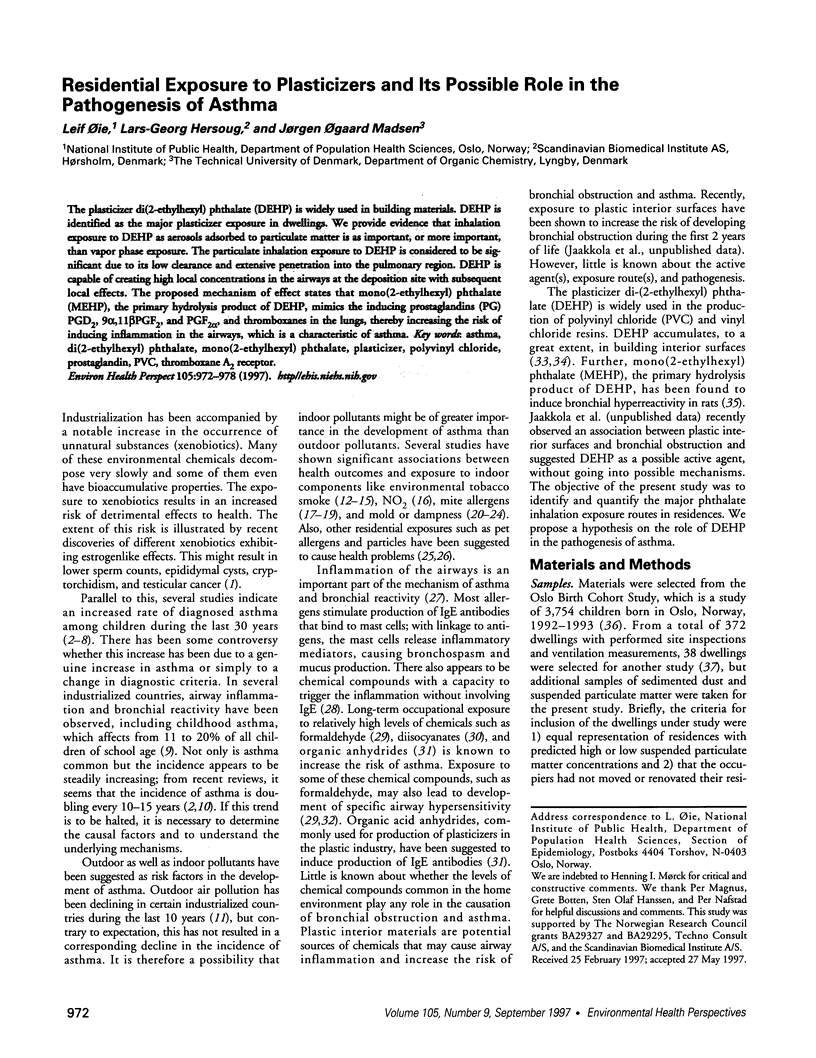
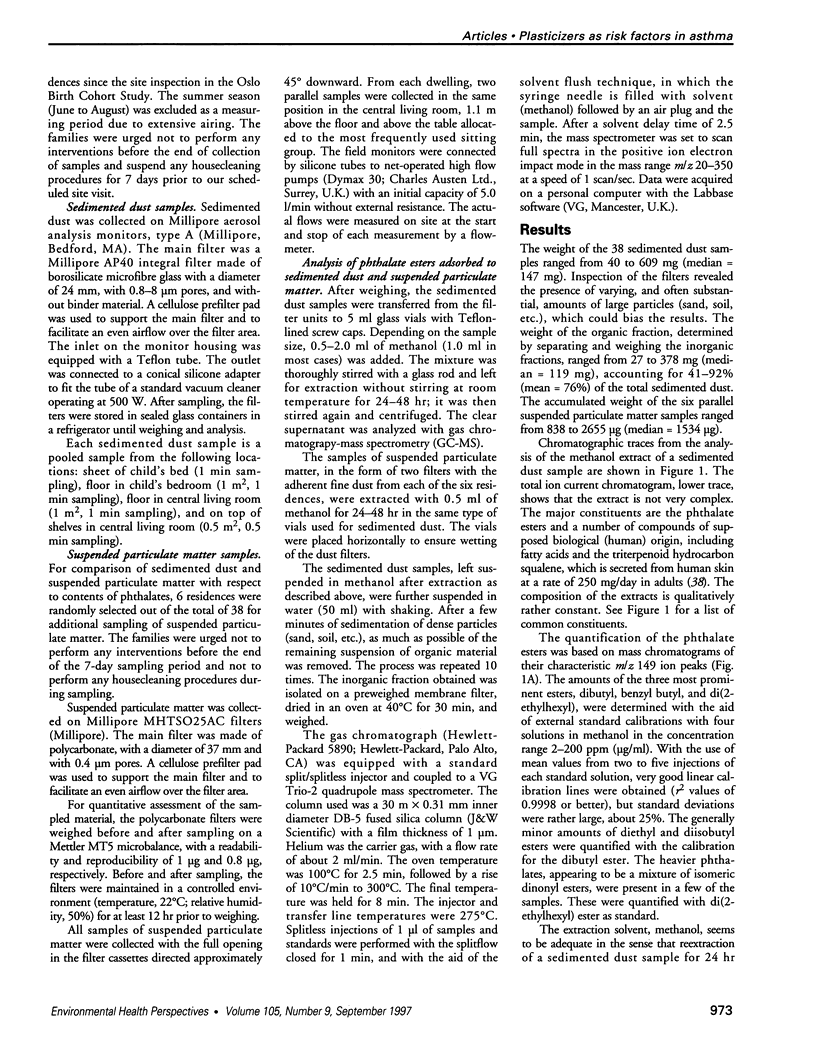
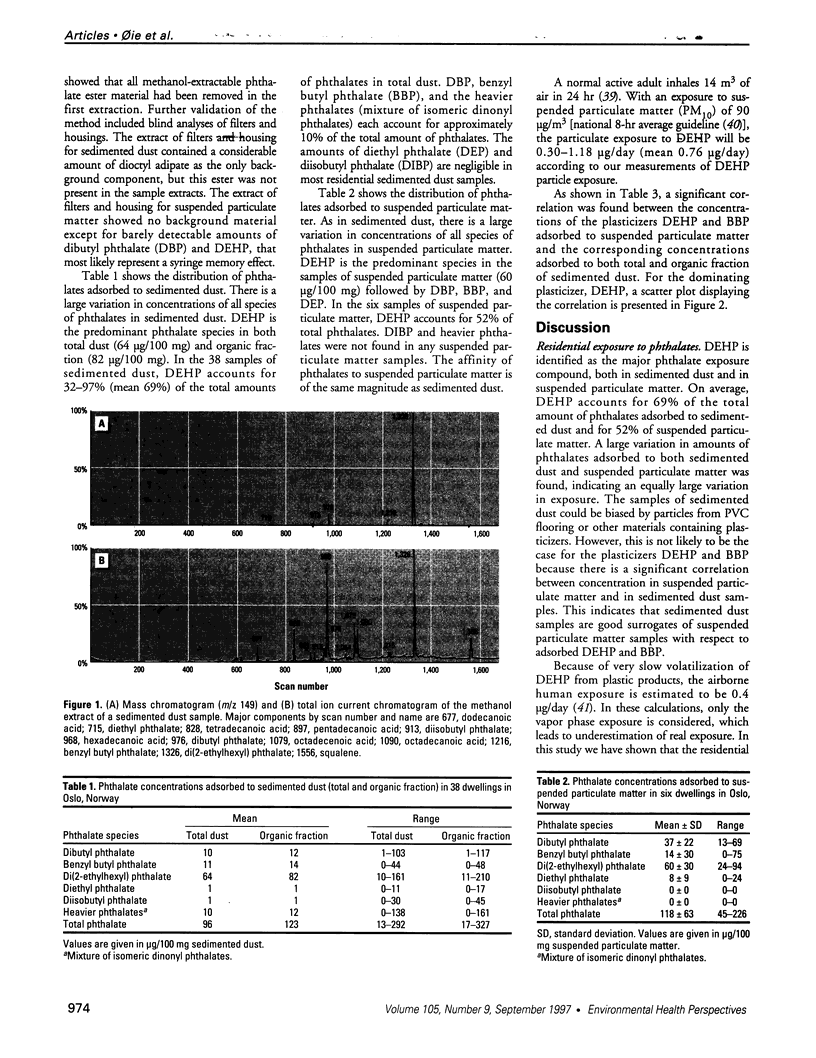
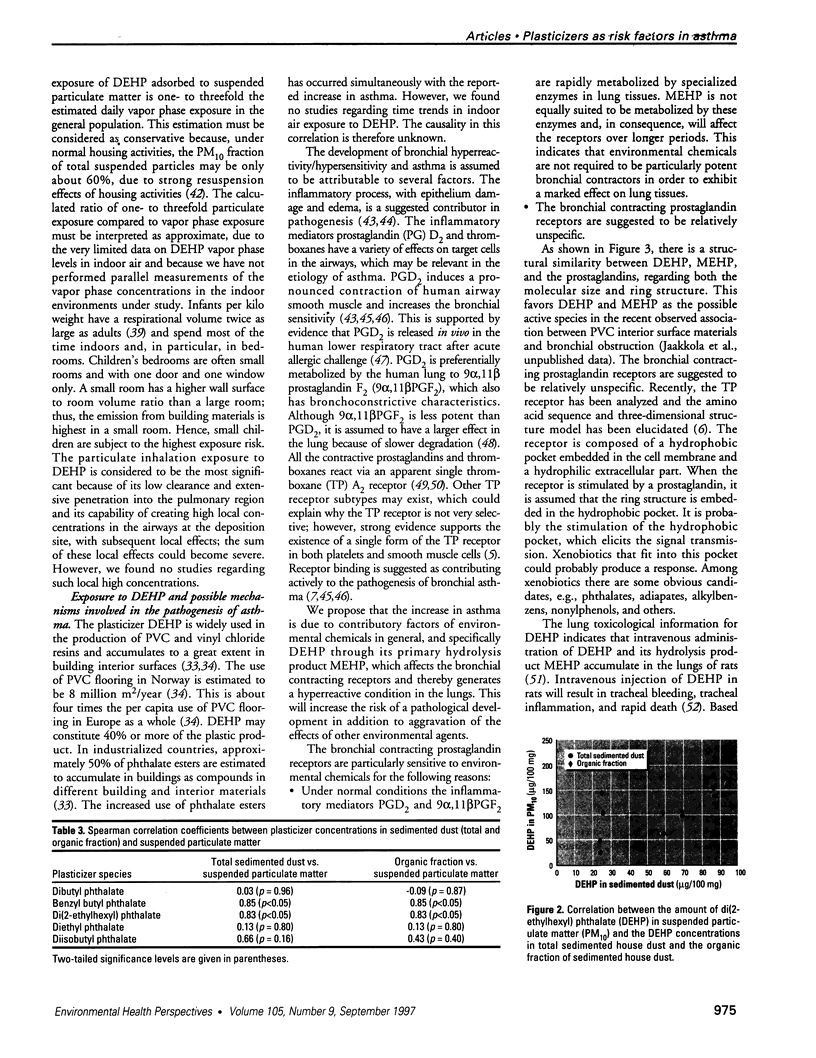
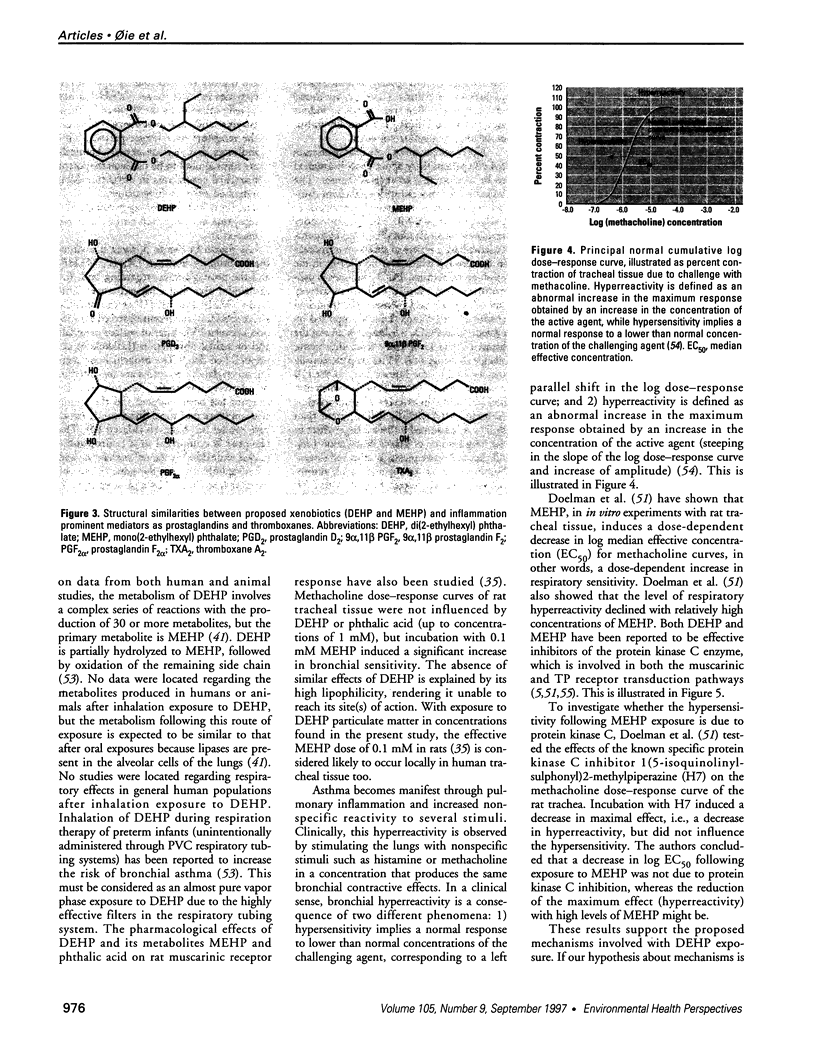
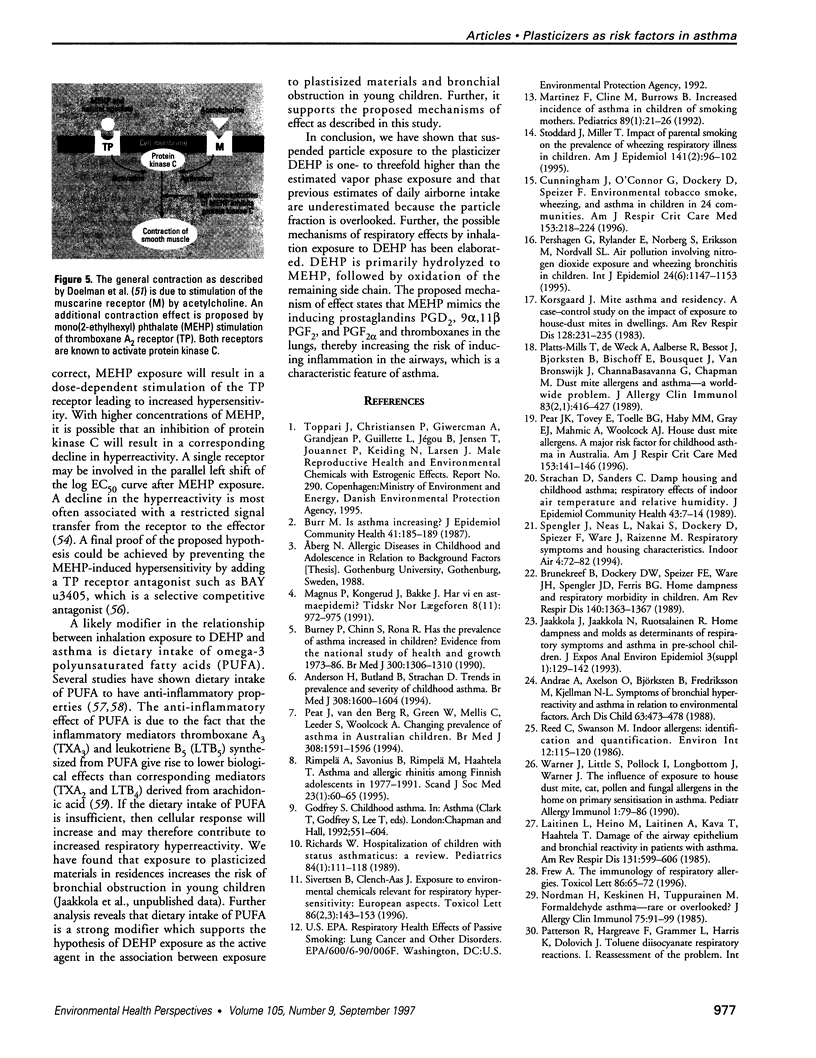
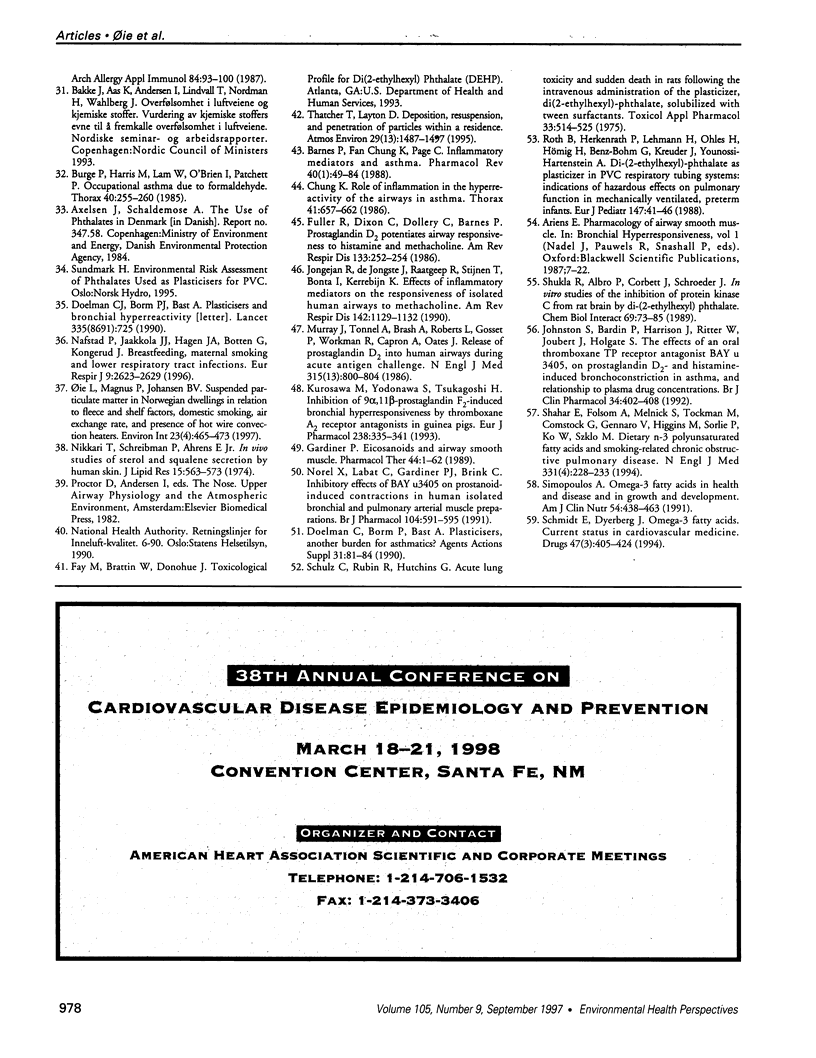
Images in this article
Selected References
These references are in PubMed. This may not be the complete list of references from this article.
- Anderson H. R., Butland B. K., Strachan D. P. Trends in prevalence and severity of childhood asthma. BMJ. 1994 Jun 18;308(6944):1600–1604. doi: 10.1136/bmj.308.6944.1600. [DOI] [PMC free article] [PubMed] [Google Scholar]
- Andrae S., Axelson O., Björkstén B., Fredriksson M., Kjellman N. I. Symptoms of bronchial hyperreactivity and asthma in relation to environmental factors. Arch Dis Child. 1988 May;63(5):473–478. doi: 10.1136/adc.63.5.473. [DOI] [PMC free article] [PubMed] [Google Scholar]
- Barnes P. J., Chung K. F., Page C. P. Inflammatory mediators and asthma. Pharmacol Rev. 1988 Mar;40(1):49–84. [PubMed] [Google Scholar]
- Brunekreef B., Dockery D. W., Speizer F. E., Ware J. H., Spengler J. D., Ferris B. G. Home dampness and respiratory morbidity in children. Am Rev Respir Dis. 1989 Nov;140(5):1363–1367. doi: 10.1164/ajrccm/140.5.1363. [DOI] [PubMed] [Google Scholar]
- Burge P. S., Harries M. G., Lam W. K., O'Brien I. M., Patchett P. A. Occupational asthma due to formaldehyde. Thorax. 1985 Apr;40(4):255–260. doi: 10.1136/thx.40.4.255. [DOI] [PMC free article] [PubMed] [Google Scholar]
- Burney P. G., Chinn S., Rona R. J. Has the prevalence of asthma increased in children? Evidence from the national study of health and growth 1973-86. BMJ. 1990 May 19;300(6735):1306–1310. doi: 10.1136/bmj.300.6735.1306. [DOI] [PMC free article] [PubMed] [Google Scholar]
- Burr M. L. Is asthma increasing? J Epidemiol Community Health. 1987 Sep;41(3):185–189. doi: 10.1136/jech.41.3.185. [DOI] [PMC free article] [PubMed] [Google Scholar]
- Chung K. F. Role of inflammation in the hyperreactivity of the airways in asthma. Thorax. 1986 Sep;41(9):657–662. doi: 10.1136/thx.41.9.657. [DOI] [PMC free article] [PubMed] [Google Scholar]
- Cunningham J., O'Connor G. T., Dockery D. W., Speizer F. E. Environmental tobacco smoke, wheezing, and asthma in children in 24 communities. Am J Respir Crit Care Med. 1996 Jan;153(1):218–224. doi: 10.1164/ajrccm.153.1.8542119. [DOI] [PubMed] [Google Scholar]
- Doelman C. J., Borm P. J., Bast A. Plasticisers and bronchial hyperreactivity. Lancet. 1990 Mar 24;335(8691):725–725. doi: 10.1016/0140-6736(90)90839-w. [DOI] [PubMed] [Google Scholar]
- Doelman C. J., Borm P. J., Bast A. Plasticisers, another burden for asthmatics? Agents Actions Suppl. 1990;31:81–84. doi: 10.1007/978-3-0348-7379-6_10. [DOI] [PubMed] [Google Scholar]
- Dust mite allergens and asthma--a worldwide problem. J Allergy Clin Immunol. 1989 Feb;83(2 Pt 1):416–427. doi: 10.1016/0091-6749(89)90128-0. [DOI] [PubMed] [Google Scholar]
- Frew A. J. The immunology of respiratory allergies. Toxicol Lett. 1996 Aug;86(2-3):65–72. doi: 10.1016/0378-4274(96)03674-0. [DOI] [PubMed] [Google Scholar]
- Fuller R. W., Dixon C. M., Dollery C. T., Barnes P. J. Prostaglandin D2 potentiates airway responsiveness to histamine and methacholine. Am Rev Respir Dis. 1986 Feb;133(2):252–254. doi: 10.1164/arrd.1986.133.2.252. [DOI] [PubMed] [Google Scholar]
- Gardiner P. J. Eicosanoids and airway smooth muscle. Pharmacol Ther. 1989;44(1):1–62. doi: 10.1016/0163-7258(89)90090-9. [DOI] [PubMed] [Google Scholar]
- Jaakkola J. J., Jaakkola N., Ruotsalainen R. Home dampness and molds as determinants of respiratory symptoms and asthma in pre-school children. J Expo Anal Environ Epidemiol. 1993;3 (Suppl 1):129–142. [PubMed] [Google Scholar]
- Johnston S. L., Bardin P. G., Harrison J., Ritter W., Joubert J. R., Holgate S. T. The effects of an oral thromboxane TP receptor antagonist BAY u 3405, on prostaglandin D2- and histamine-induced bronchoconstriction in asthma, and relationship to plasma drug concentrations. Br J Clin Pharmacol. 1992 Nov;34(5):402–408. doi: 10.1111/j.1365-2125.1992.tb05649.x. [DOI] [PMC free article] [PubMed] [Google Scholar]
- Jongejan R. C., de Jongste J. C., Raatgeep R. C., Stijnen T., Bonta I. L., Kerrebijn K. F. Effects of inflammatory mediators on the responsiveness of isolated human airways to methacholine. Am Rev Respir Dis. 1990 Nov;142(5):1129–1132. doi: 10.1164/ajrccm/142.5.1129. [DOI] [PubMed] [Google Scholar]
- Korsgaard J. Mite asthma and residency. A case-control study on the impact of exposure to house-dust mites in dwellings. Am Rev Respir Dis. 1983 Aug;128(2):231–235. doi: 10.1164/arrd.1983.128.2.231. [DOI] [PubMed] [Google Scholar]
- Kurosawa M., Yodonawa S., Tsukagoshi H. Inhibition of 9 alpha,11 beta-prostaglandin F2-induced bronchial hyperresponsiveness by thromboxane A2 receptor antagonists in guinea pigs. Eur J Pharmacol. 1993 Jul 20;238(2-3):335–341. doi: 10.1016/0014-2999(93)90865-f. [DOI] [PubMed] [Google Scholar]
- Laitinen L. A., Heino M., Laitinen A., Kava T., Haahtela T. Damage of the airway epithelium and bronchial reactivity in patients with asthma. Am Rev Respir Dis. 1985 Apr;131(4):599–606. doi: 10.1164/arrd.1985.131.4.599. [DOI] [PubMed] [Google Scholar]
- Magnus P., Kongerud J., Bakke J. V. Har vi en astmaepidemi? Tidsskr Nor Laegeforen. 1991 Mar 20;111(8):972–975. [PubMed] [Google Scholar]
- Martinez F. D., Cline M., Burrows B. Increased incidence of asthma in children of smoking mothers. Pediatrics. 1992 Jan;89(1):21–26. [PubMed] [Google Scholar]
- Murray J. J., Tonnel A. B., Brash A. R., Roberts L. J., 2nd, Gosset P., Workman R., Capron A., Oates J. A. Release of prostaglandin D2 into human airways during acute antigen challenge. N Engl J Med. 1986 Sep 25;315(13):800–804. doi: 10.1056/NEJM198609253151304. [DOI] [PubMed] [Google Scholar]
- Nafstad P., Jaakkola J. J., Hagen J. A., Botten G., Kongerud J. Breastfeeding, maternal smoking and lower respiratory tract infections. Eur Respir J. 1996 Dec;9(12):2623–2629. doi: 10.1183/09031936.96.09122623. [DOI] [PubMed] [Google Scholar]
- Nikkari T., Schreibman P. H., Ahrens E. H., Jr In vivo studies of sterol and squalene secretion by human skin. J Lipid Res. 1974 Nov;15(6):563–573. [PubMed] [Google Scholar]
- Nordman H., Keskinen H., Tuppurainen M. Formaldehyde asthma--rare or overlooked? J Allergy Clin Immunol. 1985 Jan;75(1 Pt 1):91–99. doi: 10.1016/0091-6749(85)90018-1. [DOI] [PubMed] [Google Scholar]
- Norel X., Labat C., Gardiner P. J., Brink C. Inhibitory effects of BAY u3405 on prostanoid-induced contractions in human isolated bronchial and pulmonary arterial muscle preparations. Br J Pharmacol. 1991 Nov;104(3):591–595. doi: 10.1111/j.1476-5381.1991.tb12474.x. [DOI] [PMC free article] [PubMed] [Google Scholar]
- Peat J. K., Tovey E., Toelle B. G., Haby M. M., Gray E. J., Mahmic A., Woolcock A. J. House dust mite allergens. A major risk factor for childhood asthma in Australia. Am J Respir Crit Care Med. 1996 Jan;153(1):141–146. doi: 10.1164/ajrccm.153.1.8542107. [DOI] [PubMed] [Google Scholar]
- Peat J. K., van den Berg R. H., Green W. F., Mellis C. M., Leeder S. R., Woolcock A. J. Changing prevalence of asthma in Australian children. BMJ. 1994 Jun 18;308(6944):1591–1596. doi: 10.1136/bmj.308.6944.1591. [DOI] [PMC free article] [PubMed] [Google Scholar]
- Pershagen G., Rylander E., Norberg S., Eriksson M., Nordvall S. L. Air pollution involving nitrogen dioxide exposure and wheezing bronchitis in children. Int J Epidemiol. 1995 Dec;24(6):1147–1153. doi: 10.1093/ije/24.6.1147. [DOI] [PubMed] [Google Scholar]
- Richards W. Hospitalization of children with status asthmaticus: a review. Pediatrics. 1989 Jul;84(1):111–118. [PubMed] [Google Scholar]
- Rimpelä A. H., Savonius B., Rimpelä M. K., Haahtela T. Asthma and allergic rhinitis among Finnish adolescents in 1977-1991. Scand J Soc Med. 1995 Mar;23(1):60–65. doi: 10.1177/140349489502300111. [DOI] [PubMed] [Google Scholar]
- Roth B., Herkenrath P., Lehmann H. J., Ohles H. D., Hömig H. J., Benz-Bohm G., Kreuder J., Younossi-Hartenstein A. Di-(2-ethylhexyl)-phthalate as plasticizer in PVC respiratory tubing systems: indications of hazardous effects on pulmonary function in mechanically ventilated, preterm infants. Eur J Pediatr. 1988 Jan;147(1):41–46. doi: 10.1007/BF00442609. [DOI] [PubMed] [Google Scholar]
- Schmidt E. B., Dyerberg J. Omega-3 fatty acids. Current status in cardiovascular medicine. Drugs. 1994 Mar;47(3):405–424. doi: 10.2165/00003495-199447030-00003. [DOI] [PubMed] [Google Scholar]
- Schulz C. O., Rubin R. J., Hutchins G. M. Acute lung toxicity and sudden death in rats following the intravenous administration of the plasticizer, di(2-ethylhexyl)phthalate, solubilized with Tween surfactants. Toxicol Appl Pharmacol. 1975 Sep;33(3):514–525. doi: 10.1016/0041-008x(75)90077-0. [DOI] [PubMed] [Google Scholar]
- Shahar E., Folsom A. R., Melnick S. L., Tockman M. S., Comstock G. W., Gennaro V., Higgins M. W., Sorlie P. D., Ko W. J., Szklo M. Dietary n-3 polyunsaturated fatty acids and smoking-related chronic obstructive pulmonary disease. Atherosclerosis Risk in Communities Study Investigators. N Engl J Med. 1994 Jul 28;331(4):228–233. doi: 10.1056/NEJM199407283310403. [DOI] [PubMed] [Google Scholar]
- Shukla R. R., Albro P. W., Corbett J. T., Schroeder J. L. In vitro studies of the inhibition of protein kinase C from rat brain by di-(2-ethylhexyl)phthalate. Chem Biol Interact. 1989;69(1):73–85. doi: 10.1016/0009-2797(89)90100-2. [DOI] [PubMed] [Google Scholar]
- Simopoulos A. P. Omega-3 fatty acids in health and disease and in growth and development. Am J Clin Nutr. 1991 Sep;54(3):438–463. doi: 10.1093/ajcn/54.3.438. [DOI] [PubMed] [Google Scholar]
- Sivertsen B., Clench-Aas J. Exposure to environmental chemicals relevant for respiratory hypersensitivity: European aspects. Toxicol Lett. 1996 Aug;86(2-3):143–153. doi: 10.1016/0378-4274(96)83201-2. [DOI] [PubMed] [Google Scholar]
- Stoddard J. J., Miller T. Impact of parental smoking on the prevalence of wheezing respiratory illness in children. Am J Epidemiol. 1995 Jan 15;141(2):96–102. doi: 10.1093/oxfordjournals.aje.a117418. [DOI] [PubMed] [Google Scholar]
- Strachan D. P., Sanders C. H. Damp housing and childhood asthma; respiratory effects of indoor air temperature and relative humidity. J Epidemiol Community Health. 1989 Mar;43(1):7–14. doi: 10.1136/jech.43.1.7. [DOI] [PMC free article] [PubMed] [Google Scholar]







